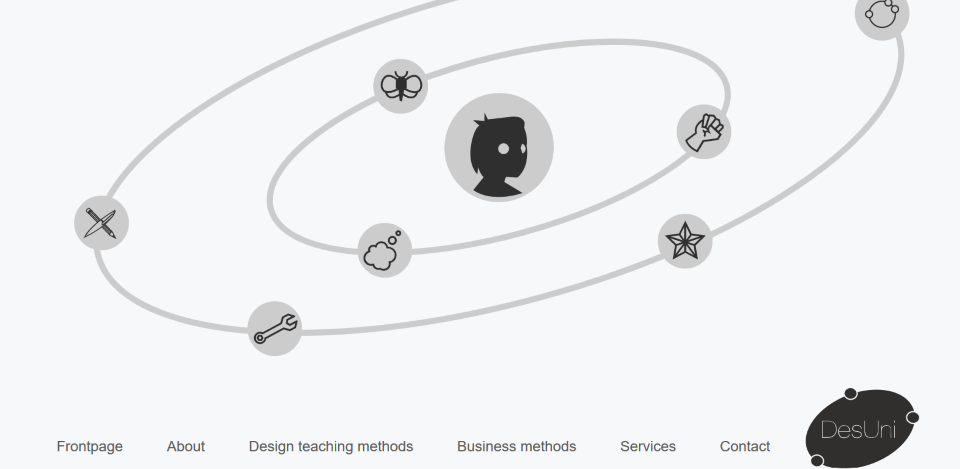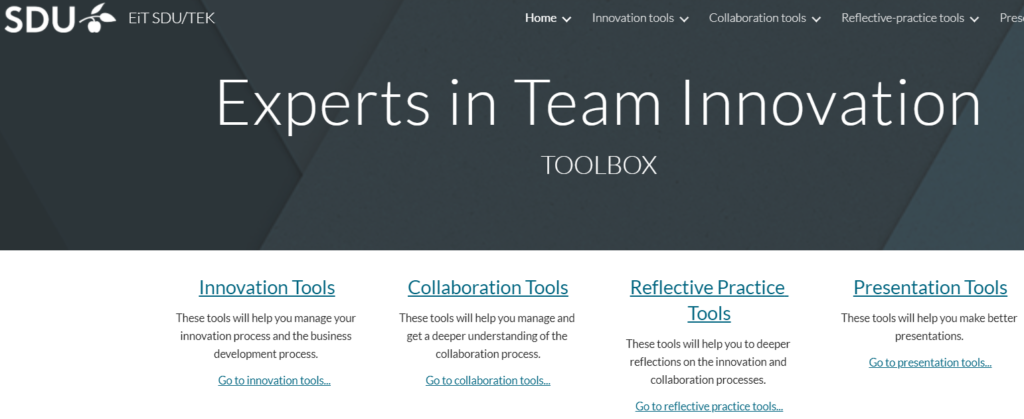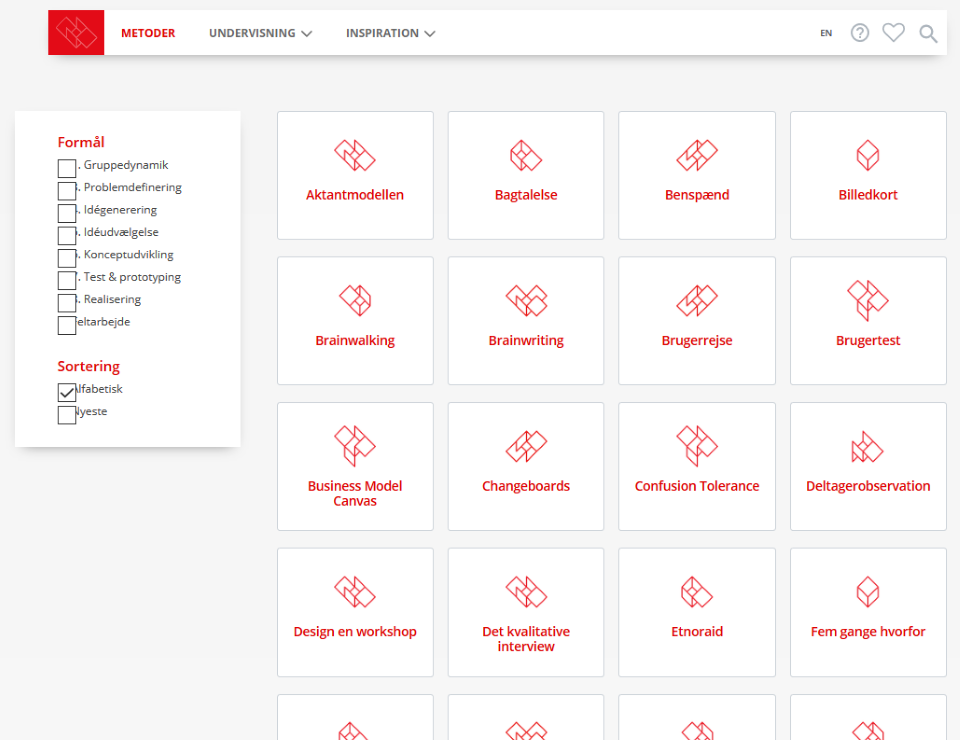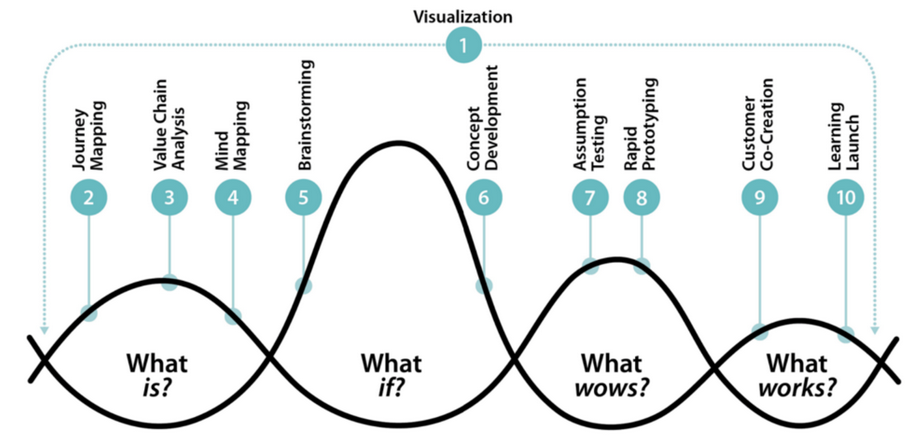Teaching innovation
A typical pedagogical challenge: often tools for innovation becomes a method for teaching. Overall course design often follows a certain design methodology from the world of innovation. This is often a brilliant idea – TWO BIRDS WITH ONE STONE – but be aware that students do not necessarily see the transfer between your choice of teaching method and the overall design methodology they should learn for their professional life.
Help students’ professional development: Discuss the intended transfer with your students.
Help your student by explicitly defining the the learning objectives for innovation methods and design process as well as the learning objectives for the subject matter.
Tools and learning designs:
DesUni (opens in a new tab)

“In order to support students, the DesUni model creates a learning environment that puts the students in a Design-Thinking frame of mind in their work with the curriculum. The DesUni model is about supporting the students in becoming the primary agents in the teaching process, and in changing their expectations from being theoretically instructed as passive receivers of knowledge, to becoming active creators of knowledge.”
Suna Løve Nielsen and Pia Storvang created this site
Toolboks Experts in Teams, SDU (opens in a new tab)

The website contains categorised tools, to help students in processes and group work. Also, you will find tools for assessment like relevant rubrics.
– Steffen Kjær Johansen maintains the EiT-site
Toolboks KU (opens in a new tab)

This tool can inspire you to find effective methods etc.
It is developed by a group of universities and the redesign in 2018 was funded by FFE
TICON – Teaching Creativity Online in Higher Education
Presentation of the TICON project
Find your material here https://www.creativityteaching.eu/upskill/
Find the tolbox here https://www.creativityteaching.eu/creativity-toolbox/
INNOVATIONSPÆDAGOGIK
Darsø, Lotte (2019). Innovationspædagogik, kunsten at fremelske innovationskompetence, Samfundslitteratur, 2. udgave, 200 sider
This book takes you through the fundamental classifications and perspectives in innovation and the fundamental perspectives on TEACHING innovation
(The book is in Danish)
Lund Petersen, K. (2019). Teaching for innovation – preparing for an uncertain future. Kbh.: Djøf publishing. 100s
Thomassen, M. L., Løje, H., & Basaiawmoit, R. V. (2018). Creativity, Invention, Innovation and Entrepreneurship, connected in theory separated in practice: – Can we strengthen engineering education by understanding the overlaps and the differences between the four concepts in an educational context. In R. Clark, P. M. Hussmann, H-M. Järvinen, M. Murphy, & M. E. Vigild (Eds.), Proceedings of the 46th SEFI Annual Conference 2018 (pp. 462-478). European Society for Engineering Education (SEFI).
Due, Brian (2014). Ideudvikling- en multimodal tilgang til innovationens kreative faser. Samfundslitteratur, 190 sider
This book takes you through a nuanced, close to practice discussion of innovation and the collaborative processes. I find the latter chapters on participants interactions, the facilitator role, and a matrix for facilitator questioning especially interesting (recommendation from Cita Nørgård)
(The book is in Danish)
Design processes
Design Sprints, Design Thinking, Google Sprints and many more … There are differences, but also a lot of similarities between the models. We have selected a few here.
Liedtka’s model

Design thinking for the greater good
Jeanne Liedtka et al
Columbia University 2017
Suggestions for further readings:
Liedtka, J. (2015). Perspective: Linking Design Thinking with Innovation Outcomes through Cognitive Bias Reduction, J prod innov manag 2015; 32(6):925-938
Liedtka, J (2020). Putting Technology in its Place: Design Thinking’s Social Technology at Work . California Management review 2020 Vol62(2) 53-83. DOI. 10.1177/0008125619897391
stanford model
Design thinking bootleg

The Design Thinking Bootleg is a set of tools and methods that we keep in our back pockets, and now you can do the same… … You can use it digitally or print the pdf and make it into a deck. There are five “modes” that we identify as components of design thinking …
Design thinking

Design Thinking Research: Looking Further: Design Thinking Beyond Solution-Fixation
by Meinel, Christoph; Leifer, Larry Understanding Innovation, 2019
more inspiration on design thinking at this link. The link also presents a short introductory video
Nicolaj Hygebjerg, (2014). Design thinking, en designers metode til innovativ ideudvikling. Nikolaj Hygebjerg & Grafisk Litteratur 2014. 77 sider.
Denne bog indeholder emner som kreativ tænkning, kreative processer, rollefordelinger og en lang stribe værktøjer og eksempler. (Kommentar af Cita Nørgård)
Robert Curedale (2018) Design Thinking, Process & Methods guide Published by Design Community College Inc. 4th edition. 598 pages.
This book shortly opens the background and history of Design Thinking and education and takes you in a detailed and structured way through the typical steps of design sprints. Many “take it or leave it” advises. (comment by Cita Nørgård)
Google Design Sprint
Creative thinking
Creative thinking is: A way of looking at problems or situations from a fresh perspective that suggests unorthodox solutions (which may look unsettling at first). Creative thinking can be stimulated both by an unstructured process such as brainstorming, and by a structured process such as lateral thinking.
Value creation
“Value Creation is Important – but we Seldom Use that Word” 2021
by Jette Seiden Hyldegård, Associate professor, Department of Communication, University of Copenhagen, DK. and Helle Meibom Færgemann, special consultant, Center for Educational Development, Aarhus
University.
[comment: this paper leads you into value creation and includes key references to the litterature on value creation]
